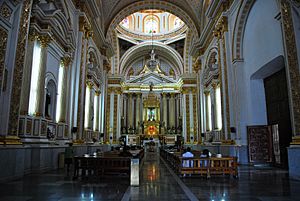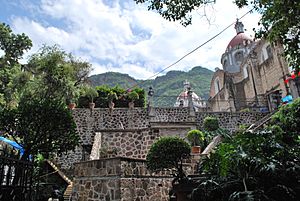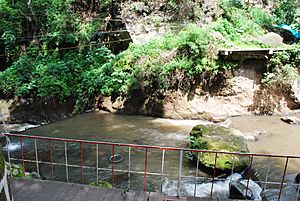Chalma, Malinalco facts for kids
Quick facts for kids
Chalma
|
|
|---|---|
|
Village
|
|

Sanctuary of Chalma with cliffs in the background
|
|
| Country | |
| State | State of Mexico |
| Municipality | Malinalco, Mexico State |
| Elevation
(of seat)
|
1,700 m (5,600 ft) |
| Population
(2005)
|
|
| • Total | 1,701 |
| Time zone | UTC-6 (CST) |
Chalma is a small village located in the State of Mexico, near the town of Malinalco. Even though it's small, Chalma is super important! It's the second most-visited pilgrimage site in all of Mexico.
People come here to visit the Sanctuary of Chalma. This special place is dedicated to a statue of a "black Christ" on a cross. A legend says this statue magically appeared in a cave. Before the Spanish arrived, people used to worship a god called Oxtoteotl in that same cave. Many of the traditions for visiting Chalma today are similar to the old rituals. These include walking on narrow paths, bathing in a special spring, and dancing at the sanctuary.
Contents
The Legend of the Christ Statue
Long ago, before the Spanish came to Mexico, people believed the caves in the Chalma area were sacred. They thought these caves were connected to a powerful god named Oxtoteotl. This god was sometimes called "the Dark Lord of the Cave." People said there was a large, black statue of Oxtoteotl in one of the caves. They believed it had magical powers and could heal people.
People would travel for days to visit this god. They wore flowers and carried special incense burners. When they arrived, they would bathe in a nearby river fed by a sacred spring. Then, they would drink holy water before going into the cave.
Around the year 1537, some Augustinian friars (religious teachers) came to the Malinalco region, which includes Chalma. They learned about the worship of Oxtoteotl. The friars wanted the local people to become Christians and stop worshipping the old god.
One popular story says that the friars asked the local people to destroy the Oxtoteotl statue. Three days later, the friars returned to the cave. Instead of the old statue, they found a life-sized statue of a crucified Christ! The old statue was found in pieces on the ground. When the local people saw the Christ statue, they were amazed. This event helped many people in the area decide to become Christians.
After this amazing event, the cave became a very popular Christian pilgrimage site. In 1643, a simple church was built nearby. Later, the Augustinian friars built a monastery and places for pilgrims to stay. By the end of the time when Spain ruled Mexico, the whole complex was known as the Royal Convent and Sanctuary of Our Lord Jesus Christ and Saint Michael of the Caves of Chalma.
Exploring the Sanctuary Complex
People continued to honor the black Christ of Chalma in the cave until 1683. That's when the Augustinian friars built a monastery right at the cave site. The Christ statue was then moved to a church built especially for it. This church is located on the canyon floor below the cave. This was the first official Sanctuary of Chalma.
The sanctuary has been rebuilt and updated many times. Major changes happened in 1721 and 1830. Its full name is "El Convento Real y Sanctuaria de Nuestro Señor Jesus Christo y San Miguel de los Cuevas de Chalma."
The sanctuary complex includes the church, the old monastery from the 1600s, and places for pilgrims to stay. These lodgings are mostly used during special feast days when many people visit. A special stucco gate marks the entrance to the holy area. In front of the church, there's a concrete plaza where mariachi musicians wait. You might even see pilgrims on their knees here.
The church's outside and inside look Neoclassic. This style came from the last big updates. A message on the church entrance says, "Come to me all you who are working and tired and I will give you rest." Inside, the church is full of religious paintings and sculptures, mostly from the 1700s.
The three main things to see are:
- The Christ of Chalma statue itself.
- A sculpture of the Archangel Michael.
- A painting of the Virgin of Guadalupe.
Other interesting paintings show scenes from the lives of Saint Augustine and Saint Nicolas Tolentino. There's also a painting about the Passion of Christ (the story of Jesus's suffering).
The Christ of Chalma statue inside the church has silver decorations added in 1534. However, this is not the original statue found in the cave. That first statue was damaged in a fire in the 1700s. The one you see today is a new version, made from what was left of the original.
A newer tradition involves the "Santo Niño del Consuelo" (Holy Child of Solace) statue. For holidays like Christmas and Epiphany, people bring toys as gifts for this statue. Outside the church, near the path to the river, there's a special area. Here, people display folk paintings called "retablos," photos, and other gifts. These are left by people who are thankful for miracles they believe the Christ of Chalma granted them.
The church at Chalma is one of the busiest in Mexico all year round. Thousands of pilgrims come because they believe the Christ of Chalma has performed many miracles.
The Pilgrimage Journey to Chalma
The Sanctuary of Chalma is one of Mexico's most-visited pilgrimage sites. Only the Basilica of Our Lady of Guadalupe gets more visitors. Since the Christ statue appeared about ten years after the Virgin of Guadalupe, some people think of her as the "mother" of this Christ figure. More than two million people visit Chalma every year! Most come from Mexican states like Querétaro, Michoacán, Oaxaca, and Guerrero. But pilgrims also come from all over the world.
Most trips to Chalma are group journeys. Different towns and villages in central Mexico have special days to visit. These trips are often to ask for blessings for their local patron saint or to celebrate a change in their "mayordomo." A mayordomo is a community leader in charge of religious traditions.
These group pilgrimages are usually very well-organized. For example, the "Procession of Silence" starts in Toluca. Some groups plan their trip a month ahead, with the mayordomo leading the effort. Some parishes even make special T-shirts or clothes for the journey. Others arrange for colorful trucks to follow the walking pilgrims, carrying supplies. Before leaving, everyone meets in their hometown.
In the past, people from nearby areas walked the entire way. Sometimes they still do, but often they combine walking with riding in vehicles. Some people even ride bicycles to the site now!
Even with modern travel, pilgrims still follow the same narrow, steep paths to Chalma that their ancestors used. They also wear flowers, just like people did long ago. If they walk at night, pilgrims carry torches and candles. Before the 1970s, walking from the main highway to Chalma village could take eight hours or more. Now there's a paved road, but it's still very winding through the mountains. Along the way, there are places for traveling pilgrims to stay, some in private homes.
Once pilgrims arrive at the sanctuary, they usually follow several traditions. One important activity is dancing in the sanctuary complex. People perform traditional dances from all over Mexico. Some pilgrims even wear their region's traditional clothing. This dancing is done to honor the Christ of Chalma and is believed to help cleanse sins. This ritual is so famous that in Mexico, there's a saying: if someone asks for something impossible, they can't do it "without going to dance at Chalma."
Many pilgrims also visit a very old Mexican cypress tree. Next to it is a spring that comes out of the ground. These are the same waters that people bathed in before Christianity arrived. For pilgrims visiting for the first time, this stop is very important. People believe the spring's water has miraculous powers. First-time pilgrims must walk around the tree three times. Many pilgrims ritually bathe in these waters. Once clean, they are crowned with flowers, ready to enter the sanctuary. Some people believe that if you don't do the ritual at the tree and spring, you might turn into stone!
On the tree, some pilgrims hang small bags with a newborn baby's umbilical cord. This is to give thanks for the birth. Others hang notes and items to show their prayers and wishes. Some women put their hands in a hole in the tree where water comes out. They then put this water on their bodies, hoping for fertility.
Inside the sanctuary, first-time visitors have a "padrino" (sponsor). This person introduces the pilgrim to the Christ statue. Those who bring sacred statues from their hometowns place them near the main altar. Mayordomos (religious leaders) watch over these statues, sometimes for up to a week. The most important ritual is to approach the Christ statue in the church, often on your knees, and kiss its foot. Some people also leave special offerings. When leaving the holy area, some pilgrims walk backward to the stucco gate before turning around.
Very large pilgrimages happen during the first Friday of Lent, Holy Week, and Pentecost. These dates are linked to the death of Christ. Also, July 1st is the feast day of the Christ of Chalma. On these special days, as many as 50,000 pilgrims might arrive in Chalma!
Having so many visitors in a tiny town can cause problems. One issue is sanitation. Also, for some poorer pilgrims, the trip can be very expensive. Food and lodging prices go up when there's high demand. This is especially true for fish meals during Lent. The most serious problem happened in 1991 during Holy Week. Twenty people died and forty were injured when crowds pushed to get into the church's atrium. Most of the dead and injured were trampled. Today, many security forces are in Chalma during these times to prevent such incidents. Helicopters and ambulances are also ready to help pilgrims.
Many Mexican Catholics believe you need to visit Chalma three times for your prayers to the Christ here to be heard.
Life in the Town of Chalma
Chalma is a small community with about 1,701 people (based on the 2005 census). It's part of the Malinalco municipality. The town is about 11 kilometers (7 miles) east of Malinalco, 65 kilometers (40 miles) from Toluca (the state capital), and 95 kilometers (59 miles) from Mexico City.
The town is surrounded by thick plants, mountains, cliffs, valleys, and fresh-water springs. The Chalma and Tlaxipehualco rivers also flow nearby. Many of these hills and cliffs have crosses on them, some over 7 meters (23 feet) tall. People believe these crosses scare away evil spirits. Each cross belongs to a specific group of worshippers. Every year, they bring their crosses down to the sanctuary to paint and decorate them. Then, they carry them back up to their spot on the mountain. This ritual ends with singing, dancing, and guarding the cross all night.
Besides the Sanctuary of Chalma, there are two other interesting places in the small town:
- Agua de Vida Park: This park, built by the State of Mexico, is meant to be a peaceful place before pilgrims reach the sanctuary. Next to the park are caves dedicated to God the Father, God the Son, and the Holy Spirit.
- Plaza de los Peregrinos: This "Plaza of the Pilgrims" was built with different levels, stairs, arches, and terraces. It's a place for pilgrims to rest and pray. Cultural and religious events also happen here. It features a mural with religious themes.
During festival days in Chalma, people create large decorations. These are panels covered with colorful flowers and seeds. Local people also make arches from tissue or crepe paper to decorate the church courtyards, plazas, and streets.
Almost everyone in Chalma makes a living from the pilgrimages. The street leading to the sanctuary is completely filled with shops and street vendors. No cars are allowed on this street. Most vendors sell religious souvenirs, plastic bottles for the spring water, and traditional Mexican food.
See also
 In Spanish: Chalma (estado de México) para niños
In Spanish: Chalma (estado de México) para niños






